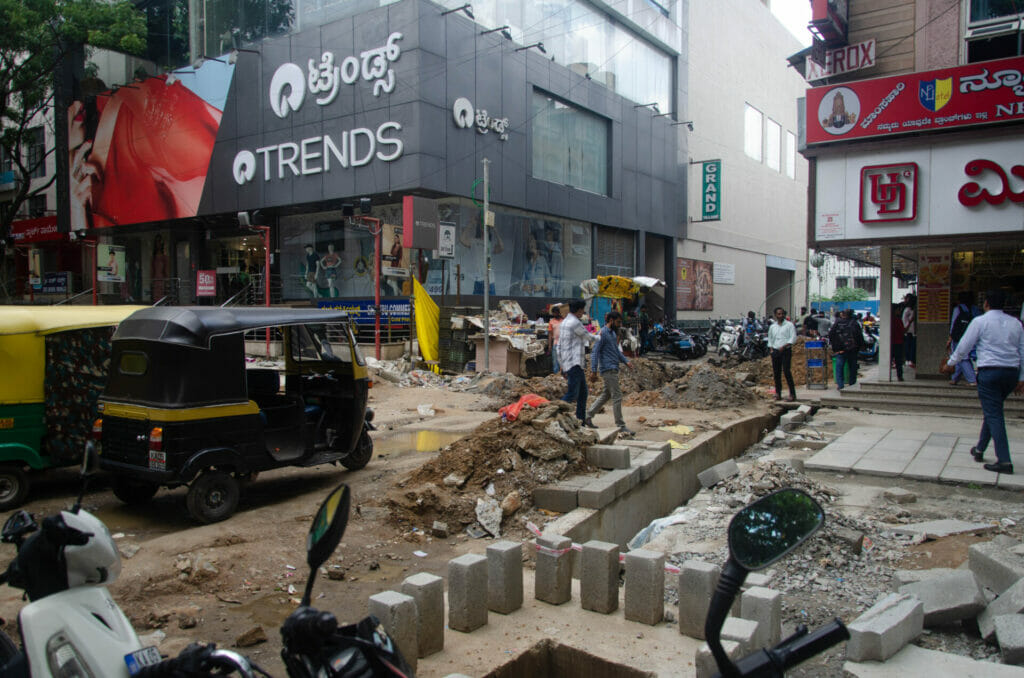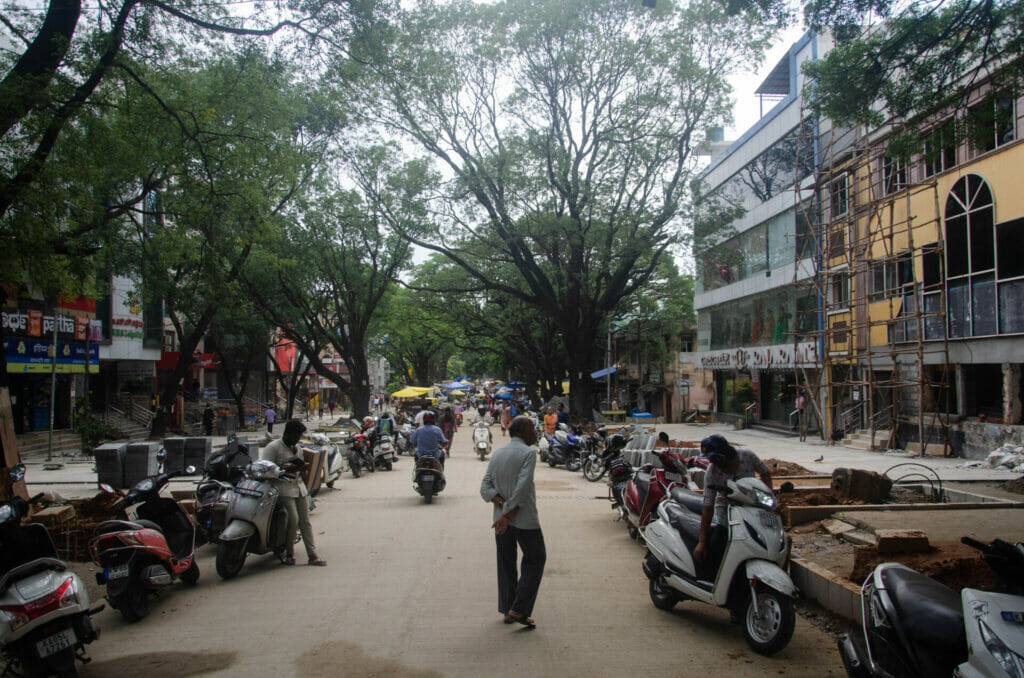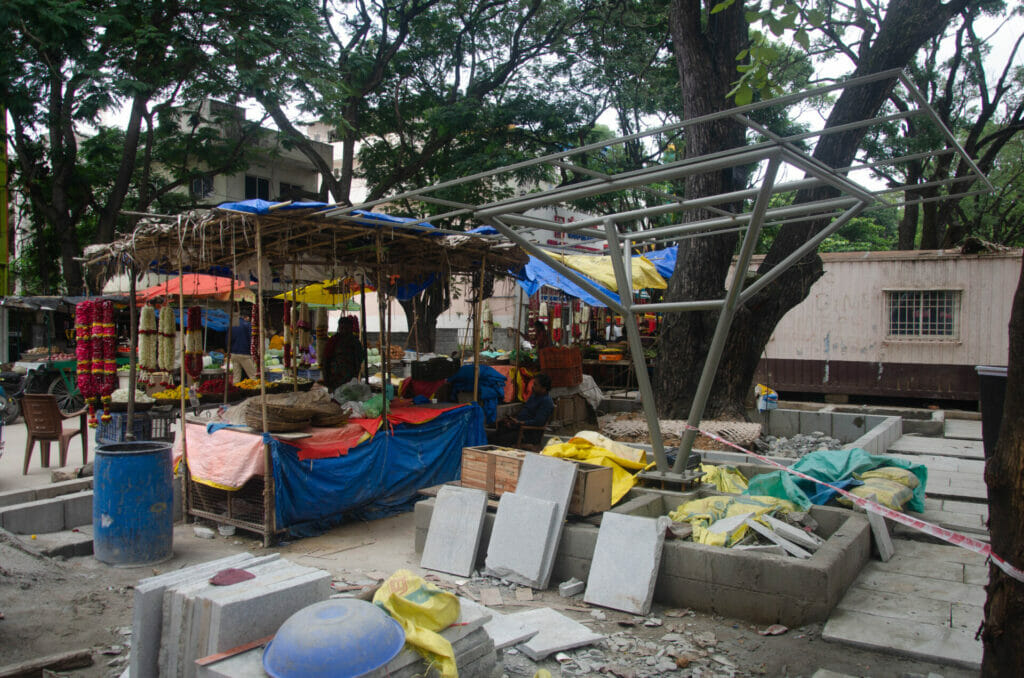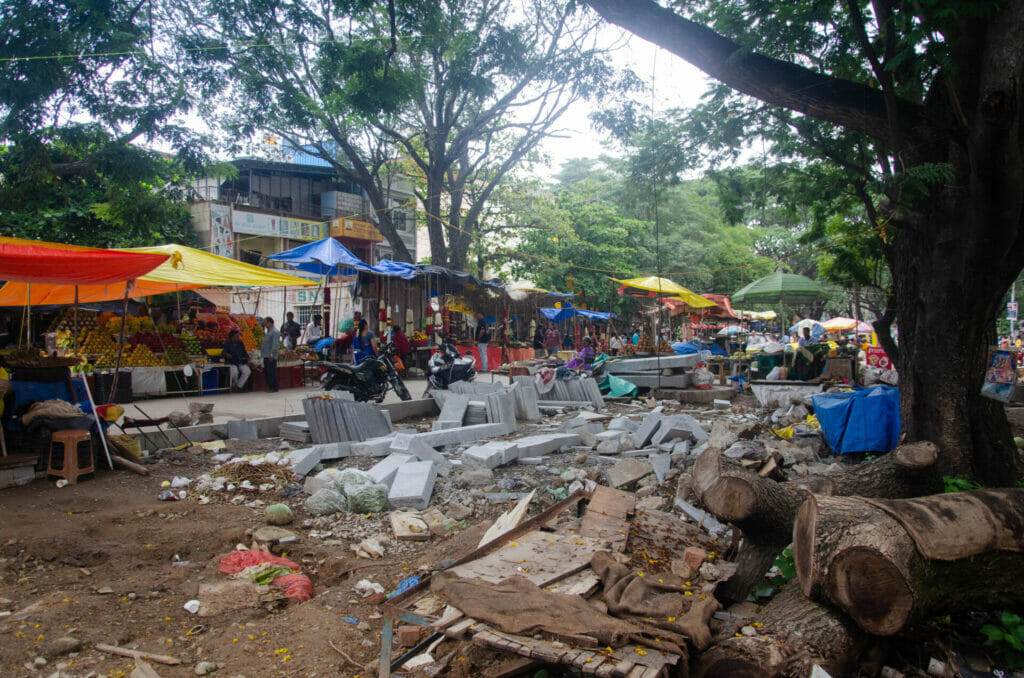For the past few months, there has been contention over the redesign of Gandhi Bazaar. The conflict at hand revolves around the clashes between the preservation of heritage and the construction of a modern shopping hub.
The primary issue is in the inability of traders/vendors and authorities to find a compromise or middle ground that satisfies both parties. There is a lack of communication and a lack of clarity regarding the existing plans for development.
While traders/vendors have objected to their recommendations not being considered, the authorities say they have documented evidence of repeated meetings and workshops held with the street vendors, traders and residents. They also claim to have modified the project as per the stakeholders’ needs.
The question of whether a Church Street model can be replicated in a street that has a strong emphasis on heritage remains uncertain. The challenge lies in the balance between redesigning Gandhi bazaar and westernising it, which the stakeholders of this project express concerns about.
However, the Bruhat Bengaluru Mahanagara Palike (BBMP) and Directorate of Urban Land Transport (DULT) claim that the they have tried to make the project as inclusive as possible.
Guru Prasad, secretary of Heritage Basavanagudi Residents Welfare Forum, doesn’t agree. He says the project was not participatory. “The people they spoke to are not even from Gandhi Bazaar. The signatures they show of approval is what we signed when we attended a meeting five years ago, which was not related to this project. We were not involved in this project at any stage,” he adds.
Details about the project
The ongoing Bengaluru Smart City Limited project, undertaken by the BBMP in collaboration with DULT was started in July 2022. The project is estimated at a cost of Rs 28 crore, with the BBMP adding Rs 6.93 crore. After receiving a positive response for making Church Street pedestrian friendly, DULT began working towards a similar project for Gandhi Bazaar.
The Detailed Project Report (DPR) for the Gandhi Bazaar plan remains absent from the public domain. “The designs are yet to be analysed and finalised. It’s a project in process and we do not want to make the DPR public before the final report is out to avoid confusion among the public,” says Manjula V, Commissioner of DULT.

Pedestrianisation idea shelved, stakeholders unconvinced
After serious objections by residents and traders, DULT decided to shelve the idea to pedestrianise the street and allow bi-directional vehicular movement. Vijay Narnapatti, chief architect at Maya Praxis, a Bengaluru-based architecture firm involved in the project for seven years, says that vehicles will be allowed in the two-way street, only parking in front of the shops would be removed and parking meters will be set up. “This not only creates more space for vendors and pedestrians, but also encourages people to use public transport,” he says.
But the vendors, traders, and residents are not convinced by this promise as they see bollards being built at the entrances and exits of the lane. “If all the entrances to the street are blocked, there will be no footfall since we are not selling any exquisite items here, only regular fruits and flowers. With that, people will naturally refuse to use pay parking and walk long distances for their daily groceries,” says Sunita, a member of the Vendors’ Association.

Modifications to the project
The upgradation of signage, lighting, landscaping, street furniture, litterbins, kiosks and stalls, the authorities argue, would improve shopping experience in Gandhi Bazaar, while preserving its cultural heritage.
As per the Indian Road Congress regulations, the 7.5-meter road will have bi-directional vehicular movement, and a carriageway, extending to the footpath, will be set up for the trees. “We cannot widen the roads since the trees’ roots are extending to the road, yet we made provision for a two-way road while preserving the environment,” says Vijay.
As per the design submitted to DULT, the vendors will be given vending zones and be kept closer to the carriageway, to allow for more space between the vendors’ stalls and traders’ shops and ensure footpath space for pedestrians.
Concerns over vending zones
However, the traders believe the vending structures will block their stores, and the vendors express concern over limited space in the vending zones. They are skeptical about BBMP building extra vending platforms and are concerned that the BBMP might rope in new vendors to occupy the vending structures, which they are against. “They have around 80 extra pillars being put up, who will they give it to?” questions Sunita.
Guru Prasad adds they did not request for any of these modern changes. All they wanted was tarring the road, leveling the footpaths and organising the street vendors. “This would have been covered within a cost of Rs 4 crore, but now with white topping and pillar constructions they are taking away the essence of this place,” he says.

While the vendors and traders have submitted a separate plan to meet their needs, they claim that it was not considered. “About 50 of us (street vendors) along with Vinay Sreenivasa of the Alternative Law Forum (ALF), submitted drawings with required changes to DULT. But it has not been taken into consideration”, says Vanaja, a member of the Street Vendors’ Association. However, DULT and BBMP claim to have accommodated these changes, accordingly, to benefit the stakeholders.
Considered all viewpoints, say redevelopers
Vijay says they made the process of revamping Gandhi Bazaar participatory, by conducting several documented workshops, meetings and exhibitions with the stakeholders from 2017. “Most of the people who attended our workshops and meetings were in favour of this project, since we are trying to organise the bazaar by keeping its heritage as a priority. But we don’t know what’s making them protest now,” says Vijay. He adds that despite regular communication with the vendors, traders and residents, he is unable to put his finger on the reasons for the contention.
They have redesigned a structure to to give street vendors a space and not just have tarpaulin coverings. They have adhered to the Street Vendors (Protection of Livelihood and Regulation of Street Vending) Act of 2014. “These places will be allotted only to the licensed vendors from the Gandhi Bazaar street, not new ones as promised by BBMP,” says Vijay.
Read more: The why’s and how’s of pedestrianising Gandhi Bazaar
Brinda Sastry, Urban Designer MayaPraxis, believes that this project is not merely an upgradation of infrastructure, but has been envisioned from the people’s perspective. “We are trying to build a sustainable supply chain, where we focus on street vending activity, maintain hygiene and provide them with infrastructure. We are also trying to enhance the pedestrian experience and preserve the spirit of this place.”
Provisions for street museums and heritage signs to represent the culture of Gandhi Bazaar have been included in the design. Stakeholders, however, believe that was not required as the essence of the place is not lost unless it is “westernised.”

Stakeholders take action
Stakeholders point out several problems with the project, like curb stones in front of residential buildings, unnecessary vending pillars, narrow roads obstructing their business and goods vehicles, and loss of culture and heritage.
Traders decided to approach the court. Basavangudi Vartakara Mandali and others have filed a writ petition in the Karnataka High Court under Article 226 and 227.
A public meeting among the traders’ association, street vendors’ association, and Residents’ Welfare Association was held on May 22nd this year to voice their concerns to Jayaram Raipura, BBMP Special Commissioner (Finance). “We must keep the pride of Bengaluru and Gandhi Bazaar’s status intact. The current design has not been set in stone, and changes will be made. A thorough inspection will be made to clear all your doubts and correct the misrepresented facts,” the Commissioner assured.
Impact of delayed project
It has been a year and the project is nowhere near completion. “We have another two-three months of work, which will be finished if there are no obstructions,” says Vijay. However, there are no answers as to how to help businesses being affected.
Venkatesh, President of the Basavangudi Traders’ Association, is concerned at the way in which Gandhi Bazaar is being revamped. “We’ve never had so many ‘to-let’ boards in this area before. Since all the entrances to the street have been dug up, businesses have suffered.” He says the work could have been completed in parts to avoid inconvenience. The problem seems to have aggravated with the monsoons. “Due to elevated footpaths, it is getting difficult to maintain the shops as water is entering each time there’s even a little rain,” Venkatesh rues.

What can be done at this stage to bridge the gap?
- Much more needs to be done to bridge communication between the traders/vendors and the authorities. There should be more forums for dialogue and trust building between the traders/vendors and the authorities.
- There should be more transparency with regard to the DPR. Plans of the Gandhi Bazaar need to be finalised soon and made available in the public domain for citizens to be informed
Suggestions by DULT
DULT identified three major problems in Gandhi Bazaar: Traffic congestion, lack of proper footpaths, existing footpaths encroached by hawkers, and illegal parking of vehicles on certain stretches.
The following suggestions were put forth:
- The Gandhi Bazaar main road would have a 4m wide pedestrian walkway/footpath on both sides
- Well-designed tree spaces would be built, which are at present damaged
- The road would be a bus-only lane with spaces for bus stops, which would be separated from pedestrians by way of barricading the bus lane
- No personal vehicles would be allowed to park on the main road and to match the parking demands, a multi-level parking facility would be provided
- Goods vehicles would only be allowed between 9 pm to 7 am for loading/ unloading purposes
- To accommodate hawkers, 5m wide hawker zones would be built all across the main road